A denim or chambray shirt can be great with tailoring. Perhaps more than anything else, they have the ability to subvert its corporate, even dandy associations. They reliably give the appearance of being both casual and practical.
The two terms, however, are used very broadly.
So in the spirit of this guide to shirting fabric, I thought we’d set out how they are defined in the industry, starting technical and then expanding into modern uses.
Denim is usually defined by its indigo-coloured warp thread and white weft thread.
This can be done in any weave structure but is usually a twill, and in jeans or other heavier cloths, a 3×1 twill.
So in a shirt, the cotton used may be a lot finer than that used for jeans, and the feeling might therefore be rather different. But it will have the same warp and weft threads, and be a twill. (Shirt and jeans shown above.)
The first way denim is thought of differently is to focus on the indigo colour – so calling a cloth denim even though it has both an indigo warp and weft, for example. This would perhaps be more accurately called ‘denim-coloured’.
And the second is to focus on the yarn and the weave. So a pair of white jeans might be referred to as denim based on the coarse cotton and 3×1 twill, even though there is no indigo.
Chambray (above and below) is sometimes unhelpfully used as a description for a lighter weight denim.
But it does have a tight definition, which is a plain-weave cloth with a coloured warp (not usually indigo) and a white weft. It is also always single ply, where denim shirting can be two ply.
Although I won’t go into the cultural histories of the two cloths (plenty on that elsewhere), it is relevant to point out that chambray was originally created as standard issue for the US Navy, and was meant to be both practical and breathable.
This is why it is light in weight and often quite open. It is also why it is associated with a slubby yarn, creating texture redolent of linen.
The original US shirts were not meant to be slubby, but became so with exposure to salt and water. (In the same way denim was not originally meant to fade, yet that is now a defining characteristic.)
Today a slub yarn is used by mills to create this effect in chambray, and this is the most common way chambray is thought of differently – by its slubbiness rather than the coloured warp/white weft.
So for example you occasionally see a ‘chambray’ shirting that has a white warp and a white weft (indeed I have one, and love it). This is basically an all-white version of the normal chambray, and might perhaps be better called a chambray effect.
Interestingly, chambray is generally thought of as being pale blue, almost as much as denim is thought of as indigo. Yet it can have any colour in the warp – from red to brown to green.
It might seem a little academic to set down definitions like this, but it is something that I find consistently confuses readers.
There is a tendency to think a term, such as ‘hopsack’, defines everything about a cloth. So a customer goes into a tailor, asks for hopsack, and is confused when shown things that they don’t think of as hopsack – because the term merely refers to a weave.
Or they ask a shirtmaker for an oxford cloth, associating it with traditional American work shirts, and are surprised when they get something rather sleek and shiny. Again, ‘oxford’ just refers to the weave.
(For a full breakdown of the different shirting weaves, see this post in this series.)
As a result, I’ve found it helpful to describe fabrics in the same way as set out above with denim and chambray, starting with their narrow definition and then expanding into other associations.
It’s a helpful framework within which to discuss why tailored denim trousers look nothing like jeans, for instance. The finer cotton means they drape and have a sharpness that clearly separates them from jeans – despite having the same yarn colours and weave.
In any modern tailored wardrobe, I think it’s worth having a fine denim shirt – such as our Everyday Denim – which is similar to a normal corporate shirt in being a two-ply yarn for example, but has a touch of the indigo shade and fades at the seams and edges.
And then it’s worth having a pale-blue chambray for the summer, which also offers an alternative to a standard business shirt – but with variation in the texture rather than fading.
Those two shirts work across smart and casual work environments. And if your office is quite formal, the rest of the wardrobe can be sharp poplins and twills. If it’s very casual, the rest can be T-shirts and polos.
Everyday Denim cloth is pictured above, and my favourite chambray – the Blueberry from Albiate – is pictured below.


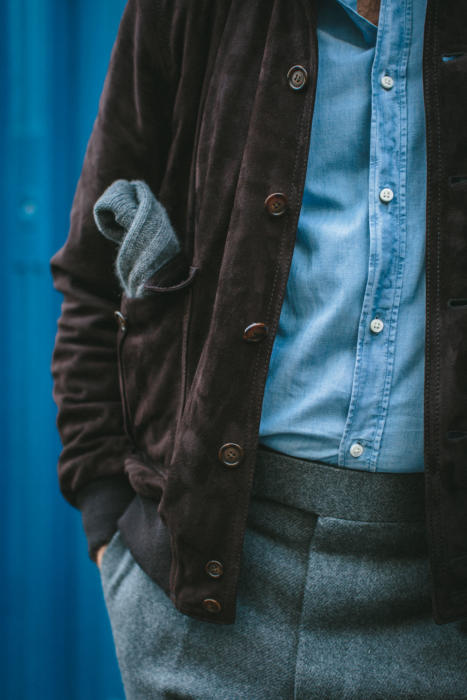
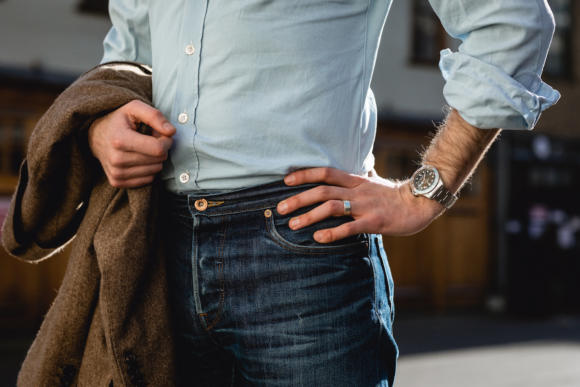
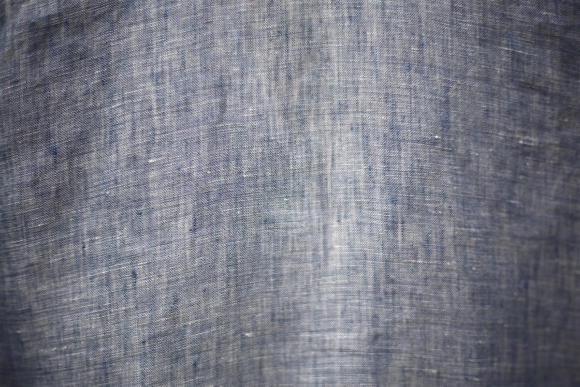
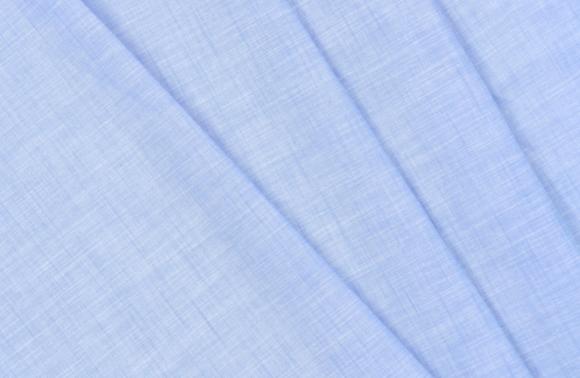
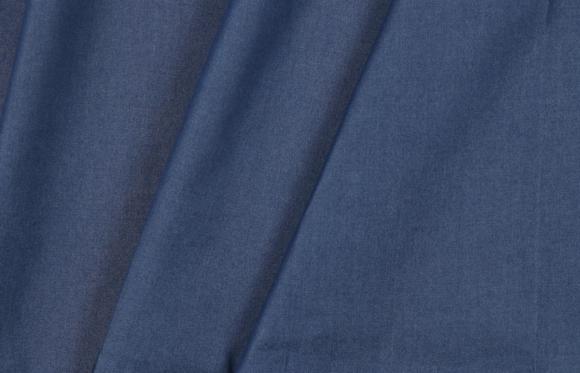




























Interesting article. So in a nutshell – what’s the difference between denim and chambray if someone was asking?
Well… the point is there is no clean and simple definition, as they are so misused. But basically, denim is a twill with indigo thread and white thread. Chambray is a plain weave (not twill) with a light blue thread and a white one. And usually slubby.
The primary difference is that, in everyday real world stuff, chambray fabrics are typically made in quite light weights compared to denims, and therefore lend themselves much better to warmer weather.
Hi Simon,
I earlier thought that the coloured warp and white weft was known as ‘end on end’, which is the fourth picture in the post? and what Drakes calls their Chambray shirts are woven using same colour threads in a one on one weave, just that the weave is slightly looser and the threads stiffer than the usual poplin.
Hi Omar,
No, with end on end, the warp of the shirting alternates a coloured yarn with a white yarn, while the weft is just one colour, usually white. See our post on weaves and designs in this series for definitions of all these.
The fourth picture here is chambray (Blueberry, Albini).
Quentissential ‘PS’ – a great post. Every flaneur worth his salt should have a couple in their wardrobe.
Quick question – in the top shot (flannel trousers), what is the technical expression for this particular shirting ?
I ask because I have a magnificent specimen from Brioni in this colour. I’ve had it for many years and it is in danger of falling apart.
The very top image? It’s just a denim shirt, in a light blue. But it’s heavily faded because it has been garment washed and probably stone washed, like most RTW denim. (For more on why that’s hard to do with bespoke, see post on Everyday Denim)
Simon,what do you think of a blue end-on-end shirt as a alternative to the shirting described above?
Nice, and not as smart as many other shirtings, but still rather smarter than denim or chambray
Glad you agree Simon.I love this weave,it’s great with a suit,smart as you say but with character and it can also be worn casually with chinos etc.Two shirts in one.
As far as I know you never wrote about silk, neither with regard to shirts nor to suits. Your guide to shirtings also contains no mention whatsoever. What’s the reason for that? Perhaps you consider silk as an impractical material (?)
Good point. Most of the time it is impractical, a little too unusual, or if shiny, then often effeminate or old fashioned. But it can be nice – I’d consider it for black tie shirts perhaps, or for an unusual summer suit alternative
It seems like Albini discontinued their “Blueberry” chambray fabric. I’m having a hard time finding it in Albini’s latest shirting collection.
Hmm, I thought it was still available. I’ll check
That would be extremely helpful! Thank you Simon
Done. It is in the Albini Su Misura Sport bunch, though not every shirtmaker will have the bunch
Is Oxford a plain weave or a twill weave? Seems to have characteristics of both
It’s neither – it’s one of the four major weave categories alongside plain, twill and complex weaves. See the ‘Weaves and deaigns’ post in this series for more detail
https://www.permanentstyle.com/2018/04/the-guide-to-shirting-weaves-and-designs.html
Dear Simon,
Thanks, an interesting read. However, as many such articles, due to length it still leaves me with quite a few questions. E.g. how to spot a chambray vs denim in the flesh and online, as the photos often seem so similar, and there are no hard definitions as you mention here and in the comments. Is twill vs plain and indigo vs no indigo the quick answer? I also struggle with understanding terms such as 2-ply and why such shirts are good/better than single-ply (is that what it’s called?), as well as ‘unlined’ tie that you mention here. I’ve only ever seen ties that have minimal lining so are almost unlined (but still are), or are 6- or 7-folds and therefore have lining made of the same fabric. And I guess knit ties are truly unlined. Oh, and I don’t understand self-tip vs non-tip vs hand-rolled etc. Can you clarify on these points? Perhaps a post of this nature on ties is also called?
Thanks!
Good points. I think the main point of posts like this is to clarify when people are confused as to what a denim or chambray is, and what that can mean. Not to spot either and identify them, as the definitions aren’t that clean, but rather to start you understanding the different aspects of the fabric, and perhaps thinking about them individually.
Two ply literally means two yarns twisted together to make one. If it’s the same overall thickness as a single ply yarn, then the single ply must be using a thicker, coarser cotton. So the latter will likely feel rougher, might not wear as well etc.
On ties, yes that’s probably a whole different post…
Thanks, this makes the points clearer.
Hi Simon, I wonder if you might be kind enough to share the code for that particular shade of the Albini Blueberry chambray – if you still have/know it, of course!
That shade isn’t available anymore I’m afraid Joe, but check out the bunch for something similar if you can find it.
Simon,
I like the chambray casual look a lot but as I generally dislike shirts with rippling/fading along the seams of plackets, collar,… (ironing issues?), I am considering a shirt with a fused collar and placket in order to reduce that effect. Would that work you reckon, any other suggestion to get less rippling?
The fading is to do with the fabric and how it’s dyed. Rippling does sometimes happen with floating collars if they’re not ironed carefully, but it won’t make a big difference to the very edges of the collar. I think that might just be the material
Hi Simon,
Do you have any recommendation for a chambray cloth to be done bespoke?
My shirtmaker (Golia, in Naples) does have primarly Canclini books but I don’t think Canclini has chambrays in theis standard offering.
Thanks!
Néstor
Hi Nestor,
I’m actually working on a really nice chambray for that reason – a Japanese one. It should be available by early April. I’d recommend waiting for that, personally.
Hi Simon, is this Japanese chambray still in the works? Obviously the world has turned upside down since this article was written. Thanks for all the great work on the site and the store
Yes it is, absolutely. India is now working again to a certain extent, so it should be ready within a month.
This is great news! Will there also be ready-made shirts? If so, when do you expect them?
There will be ready-made shirts later, yes. And perhaps some through 100 Hands retailers sooner too
That’s great news, will look to get a bolt of this when it comes into the PS shop
Hi,
That’s great news.
Thanks!
Néstor
Is a chambray shirt only a summer shirt like linen or is it wearable more months of the year than linen?
Is chambray comparable to oxford in being similar „comfortable“?
Chambray tends to be made in light cottons and so it is more often a summer cloth, but it doesn’t have to be.
Even in light cottons, I’d say it’s more a material for 6-8 months of the year – not as restrictive as linen.
And yes, it can be very comfortable like an oxford. But again, it doesn’t have to be. Some oxfords are very formal, crisp and shiny. Some chambrays can be a lot smarter too. They don’t tend to be, but always keep in mind that the name ‘oxford’ or ‘chambray’ only defines one narrow aspect of the material – in this case, the weave and the yarn colours respectively
I have a light denim shirting cloth that through some washings have turned almost white in some areas. It’s a bit embarrassing to wear outside because some areas are lighter than others.
Is this supposed to happen w/ denim shirting? Will it happen with PS everyday denim and PS lighter denim?
Hi,
Yes, in fact that was the whole point of the Everyday Denim and Lighter Denim cloths. They fade where most bespoke shirt cloths do not, and therefore can never replicate the look of ready-made, garment-washed denim shirts.
Read this post for the full background.
You might not like the look, but it is one thing that appeals to most people about denim.
Hi Simon, can you please explain the main differences between the PS Everyday Denim, and the PS Oxford. I’ve read your articles, and feel like I’m following along, but still both seem very similar to me and I can see you wearing both light blue options with similar outfits. I’m struggling to decide what is right for me… Specifically, I’d be interested to know the functional differences, such as warmth/breathability and next to skin feel. I understand that the denim will fade more than the oxford, and the oxford looks more slubby in texture, but is one more formal than the other? I currently wear my bespoke denim jeans (and sometimes brown sport jacket) more than I wear chinos, trousers and the like. Many thanks.
Hi Sam,
They are rather different, yes, even if they might be considered the same rough level of formality.
The oxford is heavier, becomes softer as it wears in, and is tougher. The denim is lighter in weight, more a standard dress shirt weight, and its attraction is the fading.
But more importantly, they are aiming at different styles. When you see someone wearing a denim shirt, it’s a particular look. Redolent of workwear and western clothing, worn in and rugged. Everyday Denim is a version of that you can wear with smarter clothing.
An oxford shirt is a very different look. It’s preppy, traditional, almost aristocratic, and very American. It’s relaxed and easy, but sophisticated.
I hope that starts to make sense.
I wouldn’t look at these two shirts and compare them – I’d look at other denim and oxford shirts, see which style you prefer, and then see if you like the way we’ve done our version of them.
By the way, both of them would feel great against skin, and work with the clothes you describe.
Thank you for the superb articles on shirting fabric! I am writing a tutorial on making jeans for dolls. One minute I think I have the fabric terms down, then I read something new and I’m not sure any more. Thank you for clearing things up.
Would you say that indigo thread almost always have a white core? For example, can I expect any indigo chambray to fade from wear? Also, is it common for non-indigo chambrays to fade in the same way?
Oh good.
No indigo threads don’t necessarily have a white core. Some are dyed all the way through – the indigo just indicates the colour rather than any dyeing technique.
And, yes some non-indigo chambrays do fade as well. I don’t know how common it is overall though.
Hi Simon. Denim, chambray, and indigo linen are my go-to shirts for making navy jackets look more casual. Just love it. But are there equivalent shirtings to equally downplay grey jackets / suits? I have been wearing white (PS OCBD, polo) but wondering if you had alternatives.
Grey is nice with colour, so perhaps try something like our Madras linen check? Or an oxford in another colour like a pink or yellow. (Pink PS one coming soon)
Simon,
The chambray pic in the article looks grey. I’ve been looking for that exact color here in the US. Any info on what color that actually is, (is that the Blueberry?) and where I might find it. Thanks and as usual, another great article.
Yes it’s the Blueberry, but I don’t it’s actually quite as grey as that in reality.
Hi Simon,
What style of a chambray shirt do you recommend for a weekend wardrobe? With a chest pocket or some other details or as simple as it may be?
Thanks
It depends how casual you want it to be. The more pockets, the more casual. I usually have mine without, as I want them to be smart enough for tailoring too
I am planning to buy a shirt which I can wear casually with chinos or linen trousers and without a jacket, for a weekend capsule wardrobe.
Can I go with navy and dark olive chambray. Do you consider it to be a good colour for chambray shirts?
I am planning to wear it untucked with cream chinos and white sneakers.
Hi Paul,
That sounds OK, but you are straying rather away from the aesthetic I usually go for. I wouldn’t wear the shirt untucked, and that’s something really more casual.
Simon! My office is quite casual and so it is mostly shirts and trousers at the office(no blazer). For summer I think oxford shirts would be too hot and dress shirts are too smart and so I was thinking of going with only chambray shirts in office with the collection of white, blue, pink and dark indigo chambray.
1) Do you think it’s a good idea?
2) Would all these colours look good in chambray?
They could all look good in chambray, yes. But obviously there will be quite a big difference in terms of how smart they look or what else they can be worn with.
Also consider linen or cotton/linen mixes
Would white and navy chambray be as versatile as white and navy oxford, and work with both jeans and smart trousers?
They should do, yes there shouldn’t be a big difference. The difference might be more in the design details, pockets and collars and so on
What is a Fil-a-Fil shirt Simon? Is chambray and fil-a-fil same?
No, fil-a-fil is a pattern created by a particular weave
Hi Simon,
I commissioned an MTM shirt using Thomas Mason’s denim cloth which I like so far except for some wrinkles created relatively quickly(within an hour) even after ironing.
I was wondering whether you think this could be due to the cloth or how it is made?
I am attaching a photo for your reference.
Many thanks,
Jack
That doesn’t look too unusual Jack, but it’s hard to say remotely. It probably depends on how you’re ironing as well
Thanks, Simon.
This is a different question, but could I ask whether you request shirt makers to slightly lower the top second button position for casual shirts (wearing without ties/opened) such as linen/buttoned down oxford?
No, but then I wear all my shirts open to the same point. And there are no functional issues when that is fastened up, to wear with a tie
Okay, thanks.
Could you possibly explain why the shirt’s collar falls in front? In other words, the collar is not flat against the neck. I have a thick neck compared to my other body parts, so the collar was cut wider than the other part of the shirt.
However, for PS shirts, the collar always stands well and flat against the neck. Could this be due to how Luca made his collar to avoid this issue or the PS cloth?
It will probably be the cloth – Luca wouldn’t make them any differently
Would a chambray shirt have the same problem as is faced by cotton trousers if I am going for made to measure option as it would not be garment washed?
I want the shirt to work for me casually.
You might struggle, yes, though perhaps more as a result of most MTM places using finer materials, really set up for smart clothing. The chambrays they would have on offer would be finer and smoother than the ones you’d find ready-made from a casual brand
Thank you!
Hello Simon,
Great series of articles.
Just to be sure I understood correctly. Chambray is always single-ply. There is no two-ply chambray?
Is there such an animal as a heavy weight chambray? I have a WWll US Navy chambray shirt that saw some action, but the fabric still feels heavier and less open than the 4-5oz chambray shirting I’ve encountered.
Any chambray shirting you would recommend? I noticed the PS chambray fabric is sold out.
Thank you.
Originally David, yes, but as I say the term chambray is also used today for a wider variety of materials, and there are certainly heavier weight and 2-ply chambrays out there. Also, a chambray can be heavier but single ply – it just means the fibre is thicker/coarser.
If you just want material, then the best book is the Canclini one, but the offering is usually fairly dressy/fine.
hi simon, am thinking of getting a natural/white chambray shirt as it is an interesting alternative to a white dress shirt. Something like this (https://thedenimstore.com.sg/product/sugar-cane-lot-no-sc27851-white-chambray-l-s-work-shirt/). However i notice almost all brands sell chambray shirts that never really white and they seem more cream/off-white. Do you think this will make it slightly more difficult to wear with say khaki chinos below? I have a cream rayon shirt from bryceland but it is very hard to pair with khaki chinos (which I almost always wear) as the colour is very close. Wondering if these white chambray shirts will have similar issues?
I know what you mean. I don’t think it will be a big issue, but you could look at something like the Rubato ones – I have one and it’s more of a white
Hi Simon,
Any recommendation, where i could source of some gray chambray shirting material? The ps chambray you had offered was great!
No I’m sorry. No one I know does narrow-width hand-loomed chambray by the metre apart from us
Could you please have a look at this indigo chambray shirt and advice me as to whether it belongs in the category of casual work shirt or is it a bit smart because of white stitching not clearly visible?
Your advice would be appreciated.
I wouldn’t say it’s a work shirt, more just an indigo dress shirt
Do you think that this shirt be a nice alternative to dark denim shirts in summer for casual wear?
I really don’t know Keshav, sorry, it’s so hard to tell from just a picture – and from a brand I’ve never bought from
All the chambray shirts featured here made by Luca Avitabile?
No, the top one is from Al Bazar, and I’d also recommend our chambray